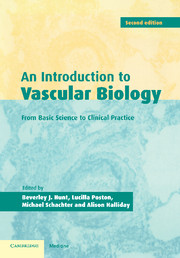Book contents
- Frontmatter
- Contents
- List of contributors
- Preface
- Part I Basic science
- Part II Pathophysiology: mechanisms and imaging
- Part III Clinical practice
- 12 Vascular biology of hypertension
- 13 Atherosclerosis
- 14 Abdominal aortic aneurysm
- 15 The vasculature in diabetes
- 16 The vasculitides
- 17 Pulmonary hypertension
- 18 Role of endothelial cells in transplant rejection
- 19 Vascular function in normal pregnancy and preeclampsia
- Index
17 - Pulmonary hypertension
Published online by Cambridge University Press: 07 September 2009
- Frontmatter
- Contents
- List of contributors
- Preface
- Part I Basic science
- Part II Pathophysiology: mechanisms and imaging
- Part III Clinical practice
- 12 Vascular biology of hypertension
- 13 Atherosclerosis
- 14 Abdominal aortic aneurysm
- 15 The vasculature in diabetes
- 16 The vasculitides
- 17 Pulmonary hypertension
- 18 Role of endothelial cells in transplant rejection
- 19 Vascular function in normal pregnancy and preeclampsia
- Index
Summary
Introduction
Pulmonary hypertension was first recognized as a distinct illness in the nineteenth century (Romberg, 1891). It required the detailed clinical descriptions of primary pulmonary hypertension (PPH) from Dresdale et al. (1951) and Wood (1952) to facilitate the modern diagnosis. In 1973, as a result of the widespread use of cardiac catheterization and detailed histopathology, a World Health Organization (WHO)-sponsored meeting was held to classify the many different forms of pulmonary hypertension. The meeting classified pulmonary hypertension into primary or unexplained pulmonary hypertension and those forms that are secondary to other disease (Hantano and Strasser, 1975). Also, the concept of pulmonary vasodilatation was introduced to encourage specific therapies for the illness. The establishment of the National Institute of Health (NIH)-sponsored register of PPH patients in the 1980s led to further changes in clinical practice, as well as basic understanding of the disease. The place of right heart catheterization was established as the essential step in diagnosis and quantification of the severity of the disease (Rich et al., 1987). Evidence of right heart failure proved valuable in predicting survival (D'Alonzo et al., 1991). In only a relatively small proportion of patients is it possible to vasodilate the pulmonary circulation.
Interest in pulmonary hypertension was increased by successful heart–lung and lung transplant surgery (Reitz et al., 1982). Limited numbers of suitable donors, however, preclude this form of treatment for the majority of patients.
- Type
- Chapter
- Information
- An Introduction to Vascular BiologyFrom Basic Science to Clinical Practice, pp. 361 - 380Publisher: Cambridge University PressPrint publication year: 2002

